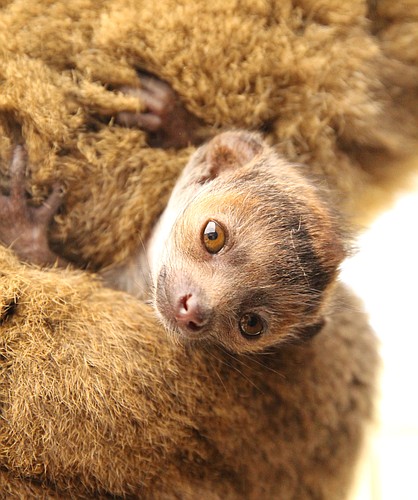- January 29, 2025
-
-
Loading

Loading

Bouncing down a dirt road leading to the Lemur Conservation Foundation in Myakka City, I was thinking this had to be a pretty good hiding place.
Although you didn't need a ladder to get out of some of those holes, it was close. I mean, nobody's going down that road who doesn't have somewhere to be.
After spending a couple hours at the foundation's 130-acre lemur reserve, my sense was that if they could, some running the reserve would dig those potholes even deeper, spread nails and add a moat.
The reserve walks a fine line; being a nonprofit, it needs to stimulate attention to get donations toward its primary goal of keeping lemurs from going extinct. But don't feel slighted if they don't invite you in. Humans have been the enemy for the past 2,000 years.
It was that long ago when people began to arrive in what is now called Madagascar, which is an island nation off the east coast of Africa in the Indian Ocean. The lemurs' rainforest and forest habitat — 90% of it — disappeared in favor of farmland.
Considering that 90% of Madagascar's animal and plant species, according to Encyclopaedia Britannica, are found nowhere else on Earth, that created quite the problem. Lemurs had nowhere to go.
Deborah Robbins Millman, the Myakka City reserve's executive director, explained that this sanctuary a world away from Madagascar is simply a "safety net" in case different species of Lemurs do disappear from their native land. She said none of the lemurs born in Myakka City will go back into the wild. Some will be sent to other reserves in the U.S. for breeding purposes.
The Lemur Conservation Foundation has three offices on Madagascar that are fighting to preserve the natural habitat that still exists for lemurs. However, as of yet, the foundation hasn't formed a collaboration with the government in Madagascar to send lemurs raised in zoos or reserves back into the wild.
"It would be a dream to work with Madagascar," Robbins Millman said.
Nevertheless, the Myakka City facility, in its 26th year, was still buzzing last week about the birth of two baby lemurs in May. A collared brown lemur was born to parents Isabelle and Oliver, and a mongoose lemur was born to Luisa and Javier. Even though preserve workers check on the babies multiple times each day after birth, they have yet to get close enough to know the sex of the two babies.
Robbins Millman said the births are great news and bring renewed optimism for the survival of the species.
Collared brown lemurs are endangered while mongoose lemurs are "critically endangered."
"Critically endangered is just one step away from ceasing to exist," she said.
The Myakka City reserve has 14 mongoose lemurs.
Robbins Millman said they could see another two or more lemurs born before the end of June, which is the end of the breeding season. Staff workers check each day for babies because lemur females, other than red ruffed lemurs, don't show if they are pregnant.
Last year, seven lemurs were born at the facility, which has 50 lemurs in five different species.
"Babies are a lot of work," senior keeper Meredith Hinton said. "We try to keep it quiet as possible, letting mom bond with the babies. We are under the impression that Mom knows best, but if we do notice Mom isn't doing well, we will intervene."
The Myakka City reserve hopes to grow and has another habitat building planned, but construction awaits final permitting by Manatee County. Robbins Millman said permitting was filed 18 months ago.
"We are eager to get it built," she said. "That will give us four buildings."
After the pandemic hit, the reserve stopped any live fundraising efforts, but Robbins Millman said they are discussing the return to live fundraising events this fall.
"People are anxious to learn about lemurs," she said.
The Lemur Conservation Foundation works with the Association of Zoos and Aquariums, which has a Species Survival Plan that the Myakka reserve follows. In the organization's 26 years, five collared-brown lemurs and 25 mongoose lemurs have been born there.
Spending time with some of the ring-tailed lemurs was fascinating and it made me think about our land problems as our growth expands to the east.
Certainly, I am a proponent for growth that feeds our economy and provides homes, businesses and jobs which make this a thriving community.
That being said, the time for the county to begin purchasing environmentally significant lands for protection is now. Voters overwhelmingly passed a referendum to create an environmental land conservation fund tax in November 2020. Let's get going on this.
Do we want to hear a reserve in Germany is a safety net because we killed all the gopher tortoises in Florida? Have we learned anything from what has happened in Madagascar and so many other places in the world?
Unfortunately for us, the Myakka City lemur reserve is not open to the pubic, but it does host visiting scientists and students studying lemur behavior.
Those who want more information about the Myakka City reserve can go to LemurReserve.org.